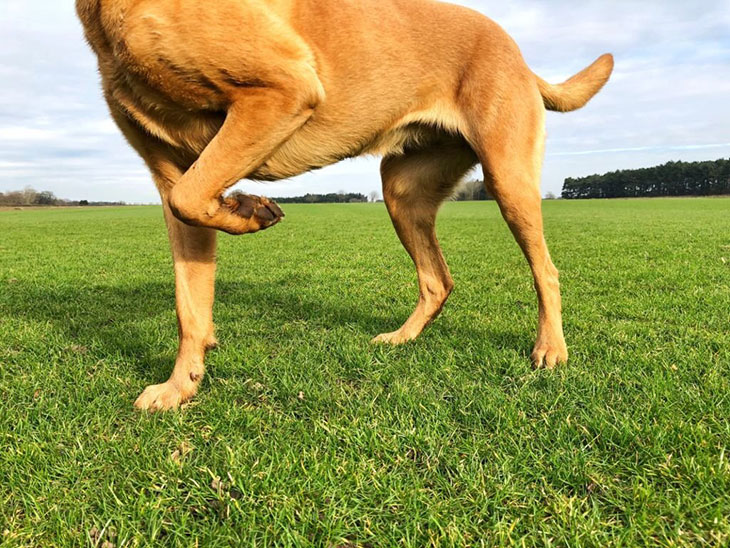A dog holding back leg up but no pain is a common claim I heard from many dog parents.
In most cases, it is just the tip of the iceberg.
There are various possible underlying causes if your dog is limping, even when you don’t see any sign of his discomfort.
Regardless of what the reason might be, it is necessary to get to the root of the problem.
In this article, I’ll suggest some of the most common factors and ailments causing dog lameness.
Why Is My Dog Holding Back Leg Up But No Pain?

While there are uncountable causes for a dog limping on back leg but not in pain, some of them seem to be more common, for example, patellar luxation, neurological causes, tick-borne disease, hip dysplasia, bone disease, muscle strain, and sprain, etc.
You might get overwhelmed to see the whole array of troublemakers involved in canine limping, from trauma to chronic illnesses.
Let’s run through 10 common names on the list of possible causes of a back-leg limping dog.
Joint Problems
Generally, there is a hidden and close relation between dog lameness and joint ailments, such as luxating patella, dysplasia, osteoarthritis, and even an infectious disease caused by ticks called Lyme, etc.
Due to those conditions, the joints in a dog’s musculoskeletal system are gradually worn and torn, resulting in its limping.
Because the symptoms and severity of limping differ by each joint disease, I would rather address it one by one below so you can easily figure out which to explain about your dog limping back leg but not in pain.
Patellar Luxation
The most common explanation for hind leg limping in dogs, especially small and toy breeds like Yorkies or dachshunds, is patellar luxation.
Usually, patellar luxation occurs before a pup reaches the age of one year, driving a dog holding back leg up on and off.
The main cause derives from a dog’s dislocated kneecap from the joint, plus the abnormal growth of its legs.
Dogs with this condition might suffer from pains between their femur, thigh bones, or two lower leg bones, which are only permanently cured by surgery.
Hip Dysplasia
Another joint-related factor that causes limping dogs is dysplasia.
While elbow dysplasia mainly affects dogs’ front legs, hip dysplasia – HD is the culprit for lameness in their back legs.
HD often starts with young pooches, whose hip balls poorly fit in the sockets.
As a result, a dog feels discomfort whenever moving its hip and putting weight on its back legs.
Over time, this structural defect silently turns them into “lazy’’ puppies who prefer sitting to rising.
The worst problem is this disorder is genetic, so you should not neglect any signs such as resistance to running or climbing stairs, difficulty walking/ getting up from lying down/ playing, etc.
Sometimes, a puppy lays down on walks is mistaken with the HD condition. Only X-ray can reveal the existence of hip dysplasia in dogs.
Lyme Disease
You might not believe your eyes when seeing an infectious disease listed here. Unfortunately, it is popularly accused of canine limping, with the ticks being the vectors.
A few months following the tick encounter, affected dogs typically start to experience unreasonable limping.
At first, the limp will start off barely perceptible; then, it gets worse over time.
Along with these symptoms, dogs with Lyme disease might suffer from fever, fatigue, enlarged lymph nodes and joints, and appetite loss.
If not diagnosed and addressed promptly, a dog can no longer walk.
The condition can be treated by veterinarians using antibiotics like Doxycycline or Cephalexin.
Prevention is better than cure. It is also crucial to provide your dog with an effective tick preventative to avoid the risk of infection.
Bone Disease
Sometimes, a dog holding up the back leg but not in pain is affected by more severe bone conditions, including hypertrophic osteodystrophy, panosteitis, or bone cancer.
Dogs with bone diseases often have unexplained limps and serious fractures, even if slightly injured.
Theoretically, bone cancer, classified as osteosarcoma and chondrosarcoma, can occur in any dog.
However, some studies show that certain breeds are more prone to bone cancers, especially large and giant dogs like Irish Wolfhound, Greyhound, Bernese Mountain Dogs, Rottweiler, Golden Retriever, etc.
It is also especially common in late middle-aged ones.
In addition to worsening lameness, lethargy, tumors, and loss of appetite are some noticeable hints of bone cancer in dogs.
Muscle Strain
Soreness in soft tissues like muscles or tendons can also explain a dog holding up back leg but not in pain.
Commonly, most mild and moderate strains can disappear without interference within a couple of days if your dog is given adequate rest and proper conditioning after high-impact exercises or heavy duties.
Sprain
Like muscle strain, sudden limping in dogs can be the consequence of overpressed ligaments.
Overweight or working pups often have a higher chance of ongoing sprains, contributing to their limping legs.
If the sprain is evidently painful and uncomfortable for your pooch, consult with the vet for diagnosis and prescription of anti-inflammatory drugs.
Neurological Causes
Brain, spinal cord, or nerve disorders might lead to a symptom of limping quite a bit.
For instance, a slipped or dislocated disc in the spine which presses on spinal cord neurons would possibly hinder the brain from sending signals to the legs, making the dog lame.
To determine whether orthopedic or neurological issues are to blame for your dog’s lameness, a medical check-up by a veterinarian is necessary.
Foreign Bodies
Sometimes, my dog is limping back leg but no pain is evidently shown because of foreign bodies like grass, seeds, thorns, and hard splinters stuck between his toes.
Skin Problems
An itchy rash or dermatitis is another reason why dogs cannot run or walk normally.
Factors, including insect stings/bites, torn toenails, or swollen or misshapen paws can cause moderate to severe pains to canine soft pads, discouraging them from putting weight on the affected limb.
What To Do With Canine Limping?

In most cases, veterinary check-up and diagnosis are valuable for pinpointing why a dog is limping.
However, you can learn, to some extent, about the typical causes of canine limping to make the first-aid assessment, know what to anticipate from a medical visit, and identify emergencies.
Assessment
Before calling for a vet, you should scan through the following steps to generally assess the situation and figure out the next course of action.
- Identify the affected leg.
- Gently palpate the limb and watch any expression of pain/ discomfort.
- Inspect the presence of any bruise, redness, swelling, torn nails, or embedded foreign objects. In case of detection, try removing them by yourself.
Be careful while touching the affected limb, as some dogs can bite you as a natural reaction when it hurts.
- Assess how serious the limp is by carefully observing your dog walk.
A keynote in the assessment of limps in dogs is the identification of gradual onset vs. sudden onset limping.
This not only helps you decide whether or not your dog’s limping constitutes a medical emergency but also assists veterinarians in figuring out the potential reasons more easily.
When To Call The Vet
Waiting a few hours for gradual or abrupt onset limps is normally fine if they don’t seem to be troubling your dog too much.
By contrast, it is a bad idea that might push the limps further from the controllable limit, especially in the following circumstances:
- Bone fractures
- Obvious break or abnormal angle
- Joint dislocations
- A hot, swollen limb
- Significant pain
- Other symptoms accompanied, such as fever, lethargy, loss of appetite, fatigue, etc.
FAQs

How Can I Know Whether My Dog Is Lame?
Lameness in dogs can be early indicated through slow walking, trouble climbing stairs, sitting too often, or hesitance to jump up.
It is also suspected if you witness your dog standing on three legs or walking with a slight skip frequently.
How Can I Determine Which Of My Dog’s Legs Is Lame?
Generally, dogs tend to shift the weight away from the painful leg.
If dogs’ front limbs are lame, their heads will likely rise when the affected leg touches the ground.
In case of hind legs limping, they will lean forward while holding the leg up to avoid weight on their rear end.
You should also notice their lifted tail/hip, a slight hop, or skip on moving.
Can I Give My Dog Aspirin for a Limp?
Aspirin and other kinds of pain relievers without a prescription or consultation from your veterinarian can potentially cause serious side effects to your dog.
It is more advisable to keep your dog from exercise or play to avoid making the dog’s limp worse instead of using a medicinal method without certainty.
Conclusion
Because of unparalleled communication, a dog holding back leg up but no pain leaves us trying to guess the underlying cause.
No matter what it is, pet parents should take initial responsibility for identifying and handling the concern asap when their dog suddenly limps in their back legs.
Minor limps without obvious pain may not necessarily require emergency care.
If the condition keeps bothering your furry friend for more than 24 hours or severe pain exists, you’d better call a vet immediately.
